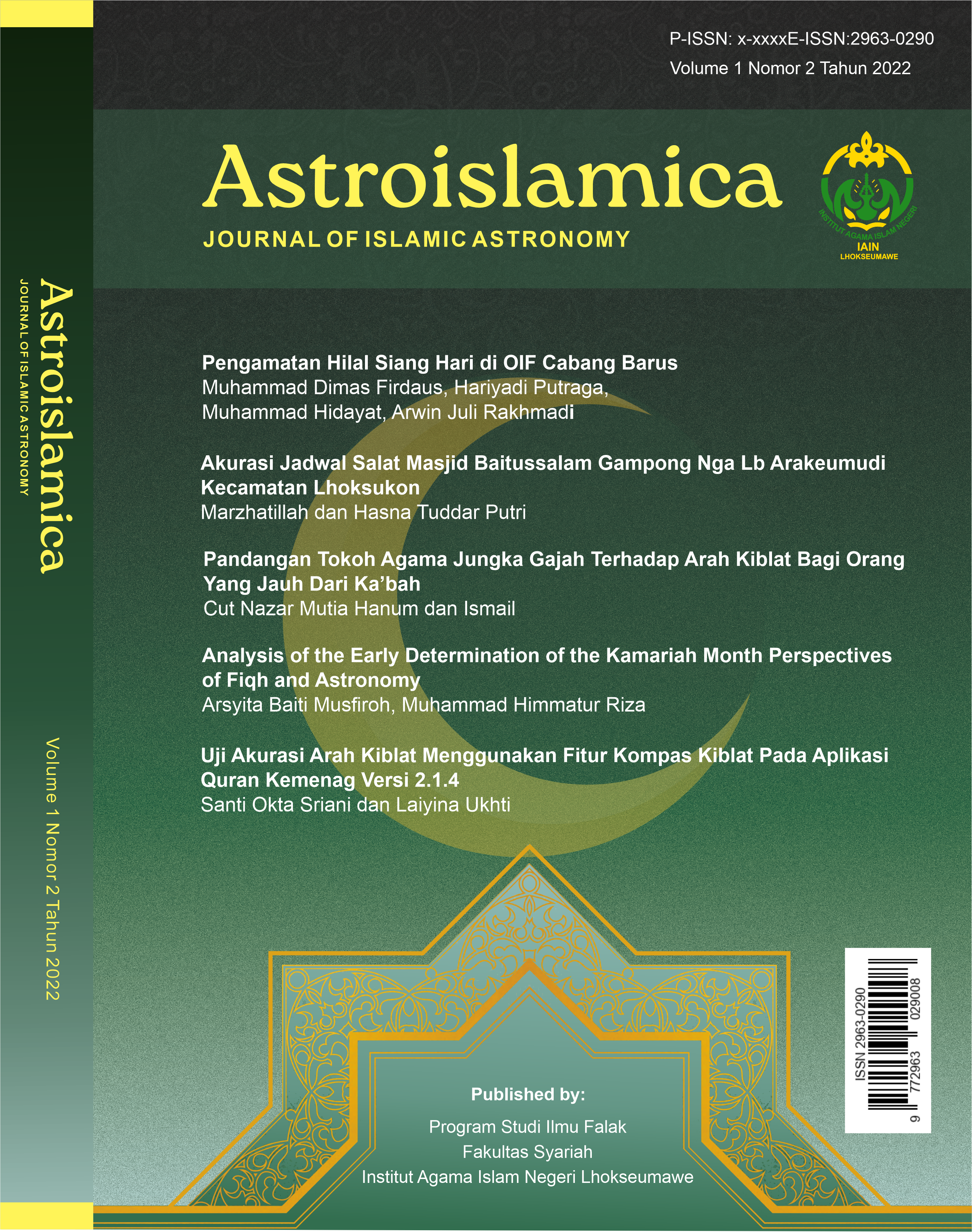Analysis of the Early Determination of the Kamariah Month Perspectives of Fiqh and Astronomy
DOI:
https://doi.org/10.47766/astroislamica.v1i2.969Keywords:
Beginning of the Lunar Month, Ministry of Religion, WeatherAbstract
The initial determination of the lunar month in Indonesia is carried out by the Ministry of Religion of the Republic of Indonesia as a government representative, with the criteria currently used being a minimum of 2o height of the new moon, 3o of elongation and 8 hours of the new moon's age. Astronomers doubt the results of the sighting without visuals from the new moon, especially when the new moon is too low, while jurists hold on to the testimony of the explorer even though there are no visual results. One of the supporting factors for the visibility of the new moon is the weather. Therefore the author formulates the problem, namely how to determine the beginning of the lunar month according to the Indonesian Ministry of Religion and analysis according to fiqh and astronomy with the study of the Decree of the Minister of Religion (KMA) regarding the determination of the beginning of Ramadan, Shawwal and Zulhijah 1435 H/ 2014 M – 1440 H/ 2019 M. This research includes a qualitative research library. The primary data source for this research is the Decree of the Minister of Religion of the Republic of Indonesia (1 Ramadan, Shawwal and Dzulhijjah) in 1381 H -1440 H / 1962 AD - 2019 AD issued by the Directorate General of Islamic Community Guidance, Ministry of Religion of the Republic of Indonesia, while secondary data sources were obtained from documents , reports, manuscripts and technical instructions that support primary data. The determination of the beginning of the lunar month carried out by the Ministry of Religion of the Republic of Indonesia is one of the government's ijtihad carried out to unite Muslims in Indonesia, the determination through an isbat meeting based on the results of reckoning and verification of the rukyatul hilal which is carried out throughout Indonesia. In fiqh terms, the determination made by the government is in accordance with fiqh principles, including hukm al-hakim ilzan wa yarfa'u al khilaf, tasharruf al-imam 'ala raiyatih manuthun bi al mashlahah, and yattabi' al mashlahah ar raajihah. Astronomically, weather factors such as air temperature, air humidity, rainfall, wind speed and direction support the sighting of the new moon during the sighting.
References
Afrizal. Metode Penelitian Kualitatif : Sebuah Upaya Mendukung Penggunaan Penelitian Kualitatif Dalam Berbagai Disiplin Ilmu. Rajawali Pers, 2017. https://opac.perpusnas.go.id/DetailOpac.aspx?id=1139943.
Ahmad, Nazhatulshima, Mohd Saiful Anwar Mohd Nawawi, Mohd Zambri Zainuddin, Zuhaili Mohd Nasir, Rossita Mohamad Yunus, and Ibrahim Mohamed. “A New Crescent Moon Visibility Criteria Using Circular Regression Model: A Case Study of Teluk Kemang, Malaysia.” Sains Malaysiana 49, no. 4 (2020). https://doi.org/10.17576/jsm-2020-4904-15.
Amin, Muhammad Faishol. “The Method of Determining Lunar Month of Four Madhhab.” Hayula: Indonesian Journal of Multidisciplinary Islamic Studies 2, no. 1 (January 31, 2018): 17–32. https://doi.org/10.21009/HAYULA.002.1.02.
Arfan Muhammad, H, and Para Hakim Dan Panmud Hukum Pengadilan Agama Kalimantan Barat. “PEDOMAN DAN TATA CARA PELAKSANAAN ITSBAT RUKYATUL HILAL DISAMPAIKAN DALAM ACARA PELATIHAN HISAB RUKYAT,” n.d.
Azhari, Susiknan. “Ensiklopedi Hisab Rukyat,” 2005, 277. https://books.google.com/books/about/Ensiklopedi_hisab_rukyat.html?id=qT9mAAAAMAAJ.
Bayong Tjasyono HK, Sri Woro B. Harijono. “Meteorologi Indonesia 2 : Awan Dan Hujan Monsun.” Accessed December 27, 2022. https://opac.perpusnas.go.id/DetailOpac.aspx?id=865089.
BMKG. “BMKG, Data Online Pusat Database.” Data Iklim Harian, 2020.
Dzajuli, Prof. H. A. “Kaidah-Kaidah Fikih,” 2019.
Fadholi, Ahmad. “Akseptabilitas Draf Kriteria Baru Penentuan Kalender Hijriah Menurut Ahli Falak Di Indonesia.” Edugama: Jurnal Kependidikan Dan Sosial Keagamaan 5, no. 1 (2019). https://doi.org/10.32923/edugama.v5i1.961.
HAMDANI, and Fahmi Fatwa Rosyadi Satria. “Ilmu Falak: Menyelami Makna Hilal Dalam Al-Qur’an,” 2017. http://repository.unisba.ac.id:8080/xmlui/handle/123456789/12967.
Ismail, I, and Abdul Ghofur. “Implementasi Maqashid Syariah Dalam Sidang Itsbat Hilal Penentuan Awal Ramadhan.” International Journal Ihya’ ’Ulum Al-Din 21, no. 1 (May 2, 2019): 80–94. https://doi.org/10.21580/IHYA.21.1.4163.
Ismail, Ismail, and Bastiar Bastiar. “Dinamika Kalender Hijriah Dalam Qanun Syariat Islam Provinsi Aceh.” Al-Qalam 26, no. 2 (November 2, 2020): 255. https://doi.org/10.31969/alq.v26i2.832.
Kementerian Agama. “Keputusan Menteri Agama RI Tentang 1 Ramadan, Syawal & Zulhijjah 1381 H-1440 H / 1962 M-2019 M.” Accessed December 27, 2022. https://simbi.kemenag.go.id/eliterasi/katalog-buku/keputusan-menteri-agama-ri-tentang-1-ramadan-syawal-zulhijjah-1381-h-1440-h-1962-m-2019-m.
———. “Selayang Pandang Hisab Rukyat - Google Books.” Bimas Islam, 2004. https://books.google.co.id/books/about/Selayang_pandang_hisab_rukyat.html?id=vo9kXwAACAAJ&redir_esc=y.
Khazi, Muhyidin; “Ilmu Falak Dalam Teori Dan Praktek/ Muhyidin Khazin,” 2005.
Khazin, Muhyiddin. “99 Tanya Jawab Masalah Hisab Dan Rukyah PDF DOWNLOAD | OPENMAKTABA.” Accessed December 27, 2022. https://openmaktaba.com/99-tanya-jawab-masalah-hisab-dan-rukyah-pdf-download/.
Mustaqim, Riza Afrian. “TRANSFORMATION OF RUKYATUL HILAL METHOD (Postmodernism Analysis of Hilal Image Processing).” Al-Hilal: Journal of Islamic Astronomy 1, no. 1 (2020). https://doi.org/10.21580/al-hilal.2019.1.1.5238.
Rahman, Asjmuni A. Qa’idah-Qa’idah Fiqih (Qawa’idul Fiqhiyyah). Bulan Bintang, 1976.
Ruslandi Ruslandi, Hasna Tuddar Putri. “Analisis Tingkat Keberhasilan Rukyat Hilal Di Observatorium Teungku Chiek Kuta Karang Lhoknga Aceh Besar.” Astroislamica: Journal of Islamic Astronomy 1, no. 1 (June 30, 2022): 97–122. https://doi.org/10.47766/ASTROISLAMICA.V1I1.690.
Su, Chunli, Yanxin Wang, Shemin Ge, Zhiheng Li, and Junxia Li. “Origin of the Crescent Moon Spring in the Gobi Desert of Northwestern China, Based on Understanding Groundwater Recharge.” Journal of Hydrology 580 (2020). https://doi.org/10.1016/j.jhydrol.2019.124344.
Sumadi Suryabrata. “Metodologi Penelitian.” Jakarta : Raja Grafindo Persada 180, no. 979-421-104–4 (2010).
“Tim Rukyat Hilal Stasiun Geofisika Waingapu BMKG Pecahkan Rekor Dunia | BMKG.” Accessed December 27, 2022. https://www.bmkg.go.id/berita/?p=tim-rukyat-hilal-stasiun-geofisika-waingapu-bmkg-pecahkan-rekor-dunia&lang=ID&tag=hilal.
Wahidi, Ahmad, Noer Yasin, Abdul Kadir, Abd. Rouf, and Saiful Haq. “Implementation of the Mabims Criteria in Determining the Beginning of Islamic Month in Indonesia and Brunei Darussalam.” In Proceedings of the International Conference on Engineering, Technology and Social Science (ICONETOS 2020), Vol. 529, 2021. https://doi.org/10.2991/assehr.k.210421.016.
Zhang, Weimin, Lihai Tan, Zhishan An, Kecun Zhang, Yang Gao, and Qinghe Niu. “Morphological Variation of Star Dune and Implications for Dune Management: A Case Study at the Crescent Moon Spring Scenic Spot of Dunhuang, China.” Journal of Arid Land 11, no. 3 (2019). https://doi.org/10.1007/s40333-019-0099-1.
Downloads
Published
Issue
Section
License
Copyright (c) 2022 Arsyita Baiti Musfiroh, Muhammad Himmatur Riza

This work is licensed under a Creative Commons Attribution-ShareAlike 4.0 International License.









